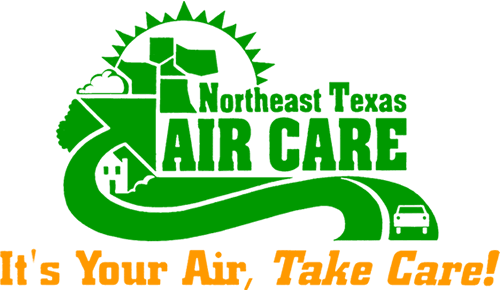What is Ozone?
The ozone layer in the upper atmosphere is beneficial because it prevents harmful ultraviolet radiation from reaching the earth's surface. This ozone in not harmful because it is higher in the atmosphere than the air we breathe. However, high concentrations of ozone at ground level may have harmful effects on many materials we use, vegetation and health.
Ozone is formed when volatile organic compounds (VOC) and nitrogen oxide (NOx) emmissions react in sunlight. Examples of VOC's are emissions from trees, gasoline vapors and paint solvents. NOx is the result of burning fuels such as natural gas, coal, gasoline and wood. Weather is a significant factor in the ozone formation process. During periods of high temperatures, low winds and intense sunlight or little cloud cover, ozone can form at ground levels when there are significant amount of VOCs and NOx present. Air from urban and metropolitan areas transported into our region can contain high levels of ozone or ozone-forming compounds. Ozone levels are highest during daytime hours from April through October since sunlight and high temperatures are necessary for high ozone levels.
What is an Ozone Action Day?
Some days are more prone to high ozone levels than others, especially summer days when temperatures climb above 90 degrees and the winds are less than 10 miles per hour. When a high ozone level is predicted, an ozone advisory for the next day will be issued to businesses, industry, governmental and media organizations. They, in turn, will then notify their employees and the public that the atmospheric conditions are conducive to the formation of high levels of ozone. On days when ozone advisories are issued, everyone will be asked to take certain actions to reduce emissions. These voluntary actions will help maintain our air quality. The Northeast Texas Air Care Association (NETAC) and local governments are coordinating efforts for public outreach through fax notifications, ozone flag program and a speakers bureau.
What can you do to help?
It may come as a surprise to know that many things we do to keep our homes clean, our yards green and even driving our vehicles contribute to ozone formation. So what can you do to help?
- Drive less. Organize a carpool, walk or ride your bike.
- Don't idle the engine of your vehicle for extended periods.
- Postpone filling your tank on hot, sunny days until late afternoon.
- Keep your car tuned up. Emissions from a poorly maintained vehicle equals that of 25 properly functioning cars.
- Insulate and weather-strip your home.
- Run dishwasher and washing machines only when there are full loads.
- Turn off lights and appliances when not in use.
- Set your thermostat between 76 and 78 degrees in the summer.
- When using a gas mower, wait until late evening to mow the lawn.
- Apply paint with rollers and brushes instead of sprays to cut down on fumes and save paint.
What can local governments do to help?
- Implement an Ozone Action Day plan.
- Postpone maintenance activities such as painting, lawn care or tank clean-outs until the Action Day has passed.
- Encourage employees to share rides or carpool.
- Use conference calls to avoid travel.
- Alter production schedules to avoid heavy production on Action Days.
- Coordinate voluntary efforts to reduce emissions through technological advances.
- Delay fleet fueling until late in the day.
- Restrict permits for outdoor burning.
- Publicize Ozone Action Days on government broadcast channels.

